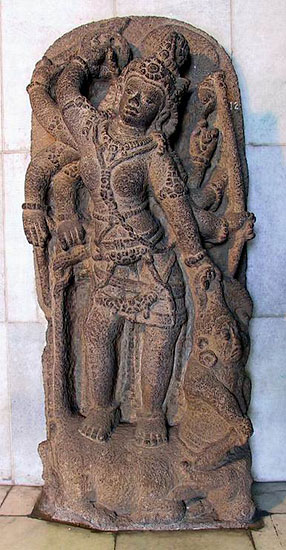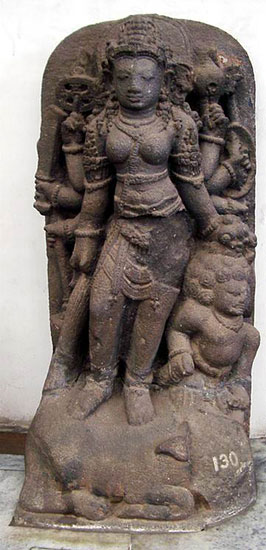Victorious Durga
Javanese Images of the Hindu Goddess Who Conquered the Buffalo Demon
by Krista Knirck-Bumke
Durga Figures in the Museum Nasional, Jakarta
The Museum Nasional has 32 Durga sculptures on display. They originate from various areas in Java dating from the 7th to the 15 th century, the Hindu-Buddhist period in the history of the Indonesian archipelago. The figures broadly come from three different areas of Java:
West Java: 4 statues, which are the earliest found so far: Cirebon (7thto 8th century, No. 5428), Preanger (8th to 9th century, No. 139), and Bandung (9th to 10th century, No. 151 and No. 149, which has no date).
Central Java: 17 statues plus 3; 9 statues dating from the 8th to the 10th century (No. 129, 153, 153a, 133a, 133b, 5547, 128, 127) and a group of 8 statues without dates but most likely from the same period. (No. 127a, 130, 133, 135, 136, 137, 140, 143, 152).
A set of 3 figures from the 8th to 9th century the origin of which is unknown (No. 5511, 5512, 131) can be ascribed to the Central Javanese group due to their characteristics and age.
East Java: 8 statues dating from the 12th to 15th century (No. 153b, 153c, 153d, 153e, 147, 146, 126d, 144 not dated).
All the images of the goddess Durga in Java exhibit the same basic features by which they can easily be identified. (No. 5512) The goddess is standing very relaxed in various poses on the back of a buffalo cowering under her feet. She
is adorned with heavy jewellery and has numerous arms; 4, 6, 8, and occasionally 10. She holds various attributes (conch, fly whisk, flower a.o.) (Detail No.130) and weapons (chakra, bow and arrow, trident, sword a.o.) and controls the buffalo by his tail. Close to the buffalo’s head arises a small, dwarf-like figure; the goddess either grabs the figure by its hair or touches its head, a humiliating gesture in Javanese eyes.
Durga Mahisasuramardini; The Myth
In Hindu cosmological perception, Durga is one of the manifestations of Sakti, the female cosmic force and energy that creates and supports the visible world. Saktiis worshipped to maintain the cycles of life and to attain enlightenment and deliverance. Sakti can take on the form of various goddesses who represent the vital and creative potency of the highest gods in the Hindu and Buddhist pantheon. So Sakti appears as goddess Lakshmi, Parvati, Durga, and Tara among others. All the goddesses are endowed with a variety of characteristics, attributes, and special powers.
The fierce and destructive form of Sakti is Durga Mahisasuramardini, literally ‘the one who crushes Asura Mahisa’, which is the demon with a buffalo appearance. Although in Hindu perception Durga is generally understood to be the wife of the god Shiva, she never appears as his consort in pictorial representations. Whereas in India she always was
and still is worshipped today in temples of her own, Durga in Java is exclusively found in candis dedicated to the god [[Shiva]. The most famous temple in Java is the Candi Lara Jonggan of Prambanan, where one of the most outstanding Durga figures is still in place in the northern niche of the temple.
The myth of Durga Mahisasuramardini is rooted in village traditions in India in early historical times and later appears in many versions in the numerous Puranas, the narrative literature in India written during the early periods
of Indian history. The most important Purana related to the stories of the great goddess is the Devi Mahatmya , which is part of the Markandeya Purana, written between the 5th and 6th centuries. The following is a condensed account of the myth:
The world was once conquered by the great demon Mahisa with his armies of Asuras, demons who conquered the world and defeated even the great gods. Upset and at a loss the gods sent out Brahma to meet the highest gods Vishnu and Shiva, who became violently angry when they heard what had happened. Out of the flames of their anger the goddess Durga
emerged. Created by the united energy of the gods, she was then equipped with weapons from them all: a trisula (trident) from Shiva; chakra from Vishnu; sword and shield from Kala, the god of time and death; noose and conch from Varuna, the god of waters; Agni, the god of fire gave his spear; Indra gave his vajra (thunderbolt); and the god of the winds, Vayu, his bow and arrow. Finally, she was dressed and adorned with jewelry from the mythical milk ocean.
Thus equipped, the goddess laughed so terrifically that the whole world started trembling. The earth bent under her feet, her crown touched the sky, the underworld vibrated with the sound of her bow, and her arms extended in all
directions throughout the world. The battle began against the army of Asuras, and when they had been defeated the great demon Mahisa himself entered the scene in the form of a buffalo.
He overcame the army of the goddess, he crushed the earth, toppled over the mountains, and rent the clouds with his horns. With his tail, he whipped the ocean so that it flooded the earth. Durga used the noose to finally catch the
buffalo, whereupon he adopted human form, then during the battle transformed himself into one animal after another, until in the end he became a buffalo again. Durga, delirious from a narcotic drink, knocked the buffalo down with the trisula, and finally decapitated it. Mahisa then emerged from the severed neck of the buffalo in human form once more.
Durga Statues in Java
The very dramatic story of Durga’s battle with the demons has been retold in many versions. Looking at the depiction of the story in the statues of Java the question is, which version backs the form of these images?
There are basically two different renderings (of five existing in the Indian art tradition) in which the Javanese Durgas are shown. The earlier one is a dramatic depiction of the helpless buffalo who has his haunches raised high as his tail is pulled up by the goddess, and the demon is controlled by the lower hand on her other side. (No. 139)The
later rendition depicts Durga standing calmly in various postures on the quietly reclining buffalo with the asura placed either beside or above his head. She holds up the buffalo’s tail while pulling the asura by his hair or just touching his head. Although in both cases the trio of goddess, buffalo, and small demon points to the story of the
dramatic events, hardly any traces of the cosmic battle can be recognized in the Javanese sculptures. None of them shows signs of the fight from which the goddess emerges so triumphantly. In some of the sculptures (No. 139, 131, 127)
she sticks the trisula into the animal’s back; this is a slightly more aggressive gesture but is more reminiscent of an act of domestication of cattle than of war. The majority of Durga statues show a very relaxed and serene figure without any traits of violence. Durga often smiles and has her eyes half closed as in meditation. (No. 133)

